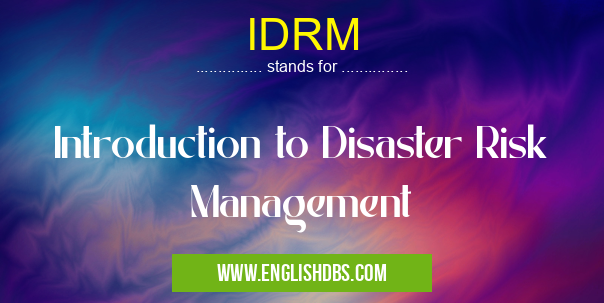What does IDRM mean in MANAGEMENT
DRM is a systematic process of using administrative directives, organizations, and operational skills and capacities to implement strategies, policies, and improved coping capacities in order to lessen the adverse impacts of hazards and related disasters.

IDRM meaning in Management in Business
IDRM mostly used in an acronym Management in Category Business that means Introduction to Disaster Risk Management
Shorthand: IDRM,
Full Form: Introduction to Disaster Risk Management
For more information of "Introduction to Disaster Risk Management", see the section below.
» Business » Management
- IDRM stands for Introduction to Disaster Risk Management. It is a comprehensive field of study and practice that focuses on understanding, assessing, and reducing risks associated with disasters.
What is IDRM?
- IDRM involves systematic efforts to identify and evaluate potential hazards, assess vulnerabilities, and implement measures to mitigate their impacts. It encompasses a wide range of activities, including disaster preparedness, risk assessment, and disaster response and recovery.
IDRM in Business
- IDRM is crucial for businesses as it helps them anticipate and prepare for potential disruptions caused by disasters. By implementing IDRM strategies, businesses can protect their operations, ensure continuity, and minimize financial losses.
Full Form and Meaning
- The full form of IDRM is "Introduction to Disaster Risk Management." It represents the fundamental principles and concepts of disaster risk management, providing a foundation for further study and application.
Essential Questions and Answers on Introduction to Disaster Risk Management in "BUSINESS»MANAGEMENT"
What is Disaster Risk Management (DRM)?
Why is Disaster Risk Management important?
DRM is essential for reducing the negative consequences of disasters, such as loss of life, property damage, and economic disruption. It helps communities understand their risks, develop plans to mitigate those risks, and prepare for and respond to disasters effectively.
What are the key elements of Disaster Risk Management?
The key elements of DRM include risk assessment, risk reduction, preparedness, and response. Risk assessment involves identifying and evaluating potential hazards and their impacts. Risk reduction aims to mitigate risks by implementing measures to reduce the likelihood and severity of disasters. Preparedness involves developing plans and procedures for responding to disasters. Response focuses on providing immediate assistance and support to affected communities.
Who is responsible for Disaster Risk Management?
DRM is a shared responsibility involving governments, businesses, communities, and individuals. Governments have a primary role in developing and implementing DRM policies and programs. Businesses and communities can contribute by implementing risk reduction measures and participating in preparedness and response activities. Individuals can take responsibility for their own safety and well-being by understanding their risks and taking appropriate precautions.
What are some best practices for Disaster Risk Management?
Best practices for DRM include conducting comprehensive risk assessments, implementing risk reduction measures based on evidence, developing and exercising emergency response plans, and promoting community engagement and education. Regular monitoring and evaluation are also crucial for ensuring the effectiveness of DRM efforts.
Final Words:
- IDRM is an essential field that contributes to building resilient communities and organizations. By understanding and managing disaster risks, we can reduce their impacts and create a safer and more secure future.
IDRM also stands for: |
|
| All stands for IDRM |
